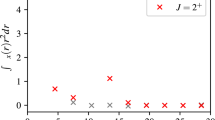Abstract.
Working within the framework of the Coulomb-modified correlation expansion for the Glauber model S-matrix, we calculate the interaction cross section (\(\sigma_{I}\)) of neon isotopes, 17-32Ne, on 12C at 240 MeV/nucleon. The calculations involve i) up to the two-body density term in the correlation expansion, and ii) the single Gaussian approximation for the nucleon-nucleon amplitude. The colliding nuclei are described with Slater determinants consisting of the harmonic oscillator single-particle wave functions. The sole input of the density of each colliding nucleus, the oscillator constant, is fixed from the respective root-mean-square (rms) radius calculated using the relativistic mean-field approach. It is found that the calculated results for \(\sigma_{I}\) generally provide fairly good agreement with the experimental data except for 31Ne, for which the required rms neutron radius comes closer to the one obtained earlier using the extended (halo-like) neutron density distribution. This finding is also supported by our predicted differential cross section of 31Ne on 12C at 240 MeV/nucleon. However, as expected, the results of the present analysis are unable to discriminate between the halo and non-halo structure of 31Ne. In conclusion, our results suggest that the present calculations can be considered as a good starting point to predict the rms matter radii of exotic neutron-rich nuclei.
Similar content being viewed by others
References
I. Tanihata et al., Phys. Rev. Lett. 55, 2676 (1985)
J. Meng, P. Ring, Phys. Rev. Lett. 77, 3963 (1996)
J. Dobaczewski, H. Flocard, J. Treiner, Nucl. Phys. A 422, 103 (1984)
I. Tanihata et al., Phys. Lett. B 206, 592 (1988)
M. Fukuda et al., Phys. Lett. B 268, 339 (1991)
T. Nakamura et al., Phys. Rev. Lett. 83, 1112 (1999)
A.H. Wapstra, G. Audi, C. Thibault, Nucl. Phys. A 729, 129 (2003)
K. Tanaka et al., Phys. Rev. Lett. 104, 062701 (2010)
M. Sharma, A. Bhagwat, Z.A. Khan, W. Haider, Y.K. Gambhir, Phys. Rev. C 83, 031601(R) (2011)
E.K. Warburton, J.A. Becker, B.A. Brown, Phys. Rev. C 41, 1147 (1990)
T. Nakamura et al., Phys. Rev. Lett. 103, 262501 (2009)
M. Takechi et al., Mod. Phys. Lett. A 25, 1878 (2010)
M. Takechi et al., Phys. Lett. B 707, 357 (2012)
Kosho Minomo et al., Phys. Rev. Lett. 108, 052503 (2012)
I. Ahmad, J. Phys. G 6, 947 (1980)
W. Czyz, L.C. Maximon, Ann. Phys. (N.Y.) 52, 59 (1969)
V. Franco, G.K. Varma, Phys. Rev. C 18, 349 (1978)
V. Franco, G.K. Varma, Phys. Rev. C 12, 225 (1975)
G. Fäldt, H. Pilkuhn, Phys. Lett. B 46, 337 (1973)
A. Ozawa, Nucl. Phys. A 709, 60 (2002)
G.D. Alkhazov et al., Nucl. Phys. A 712, 269 (2002)
B. Abu-Ibrahim, W. Horiuchi, A. Kohama, Y. Suzuki, Phys. Rev. C 77, 034607 (2008)
W. Horiuchi, Y. Suzuki, B. Abu Ibrahim, A. Kohama, Phys. Rev. C 75, 044607 (2007) 76
J. Meng, I. Tanihata, S. Yamaji, Phys. Lett. B 419, 1 (1998)
J. Meng, S.-G. Zhou, I. Tanihata, Phys. Lett. B 532, 209 (2002)
J. Meng et al., Prog. Part. Nucl. Phys. 57, 470 (2006)
Shan-Gui Zhou, Jie Meng, P. Ring, En-Guang Zhao, Phys. Rev. C 82, 011301(R) (2010)
Deeksha Chauhan, Z.A. Khan, A.A. Usmani, Phys. Rev. C 90, 024603 (2014)
T. Sumi et al., Phys. Rev. C 85, 064613 (2012)
W. Horiuchi et al., Phys. Rev. C 86, 024614 (2012)
Author information
Authors and Affiliations
Corresponding author
Additional information
Communicated by F. Gulminelli
Rights and permissions
About this article
Cite this article
Ahmad, S., Chauhan, D., Usmani, A.A. et al. Study of the neon interaction cross section using the Glauber model. Eur. Phys. J. A 52, 128 (2016). https://doi.org/10.1140/epja/i2016-16128-8
Received:
Revised:
Accepted:
Published:
DOI: https://doi.org/10.1140/epja/i2016-16128-8



